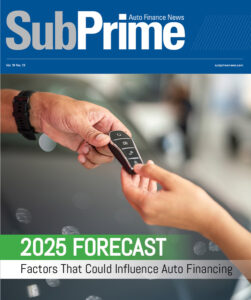Credit availability loosens, as average used-financing rate jumps to 12-year high

While some retailers seemingly started Black Friday sales promotions before Labor Day, dealerships and finance companies likely are bracing for some additional business this week as consumers feel the urge to shop and make big purchases.
As Cox Automotive noticed access to auto credit expanded slightly for the second month in a row, Edmunds shared its latest financing data to help dealerships and finance companies brace their new customers for what it will take to complete delivery of a used or new vehicle.
According to new Edmunds data, average transaction prices for new and used vehicles are softening but are still elevated year-over-year.
The average transaction price (ATP) for a new vehicle dipped to $46,991 in October compared to a peak of $47,222 in June, but still represents a 3.1% year-over-year increase compared to October of last year.
Edmunds pointed out that the ATP for a used vehicle dipped to $30,045 in October compared to a peak of $31,095 in April, but still represents a 4.7% year-over-year increase compared to last October.
Fueled in part because of Federal Reserve actions, Edmunds also noted that interest rates for new- and used-vehicle financing are skyrocketing.
Analysts said the average annual percentage rate (APR) for a financed new vehicle purchase climbed to 6.3% in October compared to 4.2% in October of last year. That’s the highest new vehicle APR since April 2019.
Edmunds determined the average APR for a used vehicle purchase climbed to 9.6% in October compared to 7.4% last October. That’s the highest since February 2010.
Analysts also indicated that many consumers are opting into longer contract terms to make monthly payments more palatable.
In fact, Edmunds data showed that 34% of financed new-model purchases had an average term of more than 73 months in October, compared to 27% in October 2017.
“Car shoppers might be going into Black Friday weekend aware that elevated prices and limited inventory will make deals harder to come by, but they might not fully understand just how critical it is to prepare for their purchase, and how they will finance it, before going to the dealer,” Edmunds’ executive director of insights Jessica Caldwell said in a news release.
“The last time interest rates were this high, consumers could at least rely on lower vehicle prices and a greater range of inventory to soften the blow. That simply isn’t the case in this market,” Caldwell continued.
While consumers seemingly will be making higher monthly payments for the duration of the installment contract, Cox Automotive highlighted greater availability of credit to make it possible.
Access to auto credit expanded slightly for the second consecutive month in October, according to the Dealertrack Credit Availability Index.
The index increased 0.2% to 103.9 in October, reflecting that auto credit was easier to get in the month compared to September.
Cox Automotive explained in a Data Point that the improvement in access reflected conditions that were loosest since June. With the increase in October, analysts said access was looser by 3.4% year-over-year. And compared to February 2020, they said access was looser by 4.8%.
“The trends in credit availability factors were mixed in October, but consumers benefited from yield spreads narrowing, subprime share increasing and the share of loans with negative equity growing,” Cox Automotive said in the report. “The average yield spread on auto loans narrowed, so rates consumers saw on auto loans were more attractive in October relative to bond yields. The average auto loan rate increased by 43 basis points in October compared to September, while the five-year U.S. Treasury increased by 49 basis points, resulting in a narrower average observed yield spread.
“The subprime share increased to 11.9% in October from 11.7% in September. The share of auto loans with negative equity also rose to the highest level since the spring of 2020,” Cox Automotive added.
Analysts recapped that each Dealertrack Auto Credit Index tracks shifts in approval rates, subprime share, yield spreads and loan details, including term length, negative equity and down payments. They mentioned each index is baselined to January 2019 to show how credit access shifts over time.

 View The Latest Edition
View The Latest Edition

